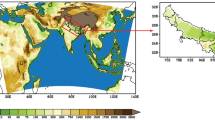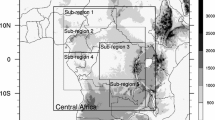Abstract
In view of a significant lacuna in the Himalaya-specific knowledge of forthcoming expected changes in the rainfall climatology, this study attempts to assess the expected changes in the Indian summer monsoon rainfall (ISMR) pattern exclusively over the Indian Himalayan Region (IHR) during 2020–2070 in comparison to a baseline period of 1970–2005 under two different warming scenarios, i.e., representative concentration pathways 4.5 and 8.5 (RCP 4.5 and RCP 8.5). Five climate model products from the Commonwealth Scientific and Industrial Research Organization initiated Coordinated Regional Climate Downscaling Experiment of World Climate Research Programme over south Asia region are used for this purpose. Among the several different features of ISMR, this study attempts to investigate expected changes in the average summer monsoon rainfall and percent monthly rainfall to the total monsoon seasonal rainfall using multimodel averages. Furthermore, this study attempts to identify the topographical ranges which are expected to be mostly affected by the changing average monsoon seasonal rainfall over IHR. Results from the multimodel average analysis indicate that the rainfall climatology is expected to increase by >0.75 mm/day over the foothills of northwest Himalaya during 2020–2070, whereas the rainfall climatology is expected to decrease for the flood plains of Brahmaputra under a warmer climate. The monthly percent rainfall of June is expected to rise by more than 1% over the northwestern Himalaya during 2020–2040 (although insignificant at p value <0.05), whereas the same for August and September is expected to decrease over the eastern Himalaya under a warmer climate. In terms of rainfall changes along the altitudinal gradient, this study indicates that the two significant rainfall regions, one at around 900 m and the other around 2000 m of the northwestern Himalaya are expected to see positive changes (>1%) in rainfall climatology during 2020–2070, whereas regions more than 1500 m in eastern Himalaya are expected to experience inconsistent variation in rainfall climatology under a warmer climate scenario.










Similar content being viewed by others
References
Bookhagen B, Burbank D (2006) Topography, relief, and TRMM-derived rainfall variations along the Himalaya. Geophys Res Lett 33(L08):405. doi:10.1029/2006GL026037
Dhar O, Rakhecha P (1981) The effect of elevation on monsoon rainfall distribution in the central Himalayas. In: Monsoon dynamics, Cambridge University Press, Cambridge
Dwivedi S, Mittal A, Goswami B (2006) An empirical rule for extended range prediction of duration of Indian summer monsoon breaks. Geophys Res Lett 33(L18):801. doi:10.1029/2006GL027035
Endris H, Omondi P, Jain S, Lennard C, Hewitson B, Changa L, Awange J, Dosio A, Ketiem P, Nikulin G, Panitz H, Buchner M, Stordal F, Tazalika L (2013) Assessment of the performance of CORDEX regional climate models in simulating East African rainfall. J Clim 26(21):8453–8475
Ghimire S, Choudhary A, Dimri A (2015) Assessment of the performance of CORDEX-south asia experiments for monsoonal precipitation over the Himalayan region during present climate: Part i. Clim Dyn. doi:10.1007/s00382-015-2747-2
Giorgi F, Jones C, Asrar G (2009) Addressing climate information needs at the regional level: the CORDEX framework. World Meteorological Organization, WMO Bulletin
Goswami B, Venugopal V, Sengupta D, Madhusoodanan M, Xavier P (2006) Increasing trend of extreme rain events over India in a warming environment. Science 314:1442–1445
Hirakuchi H, Giorgi F (1995) Multiyear present-day and 2\(\times\) \(CO_2\) simulations of monsoon climate over eastern Asia and Japan with a regional climate model nested in a general circulation model. J Geophys Res 100:21105–21125
IPCC (2007) IPCC fourth assessment report. Tech. rep, Inter governmental Panel on Climate Change
IPCC (2013) IPCC-AR5 working group report-1. Tech. rep, Inter governmental Panel on Climate Change
Jacob D, Petersen J, Eggert B, Alias A, Christensen O, Bouwer L, Braun A, Colette A et al (2014) EURO-CORDEX: new high-resolution climate change projections for European impact research. Reg Environ Change 14(2):563–578
Kim J, Waliser D, Mattmann C, Goodale C, Hart A, Zimdars P, Crichton D, Jones C, Nikulin G, Hewitson B, Jack C, Lennard C, Favre A (2014) Evaluation of the CORDEX-Africa multi-RCM hindcast: systematic model errors. Clim Dyn 42:1189–1202
Krishna Kumar K, Patwardhan S, Kulkarni A, Kamala K, Rao-Koteswara K, Jones R (2011) Simulated projections for summer monsoon climate over India by a high-resolution regional climate model (PRECIS). Curr Sci 101(3):312–326
Kulkarni A, Patwardhan S, Krishna Kumar S, Karamuri A, Krishnan R (2013) Projected climate change in the Hindu Kush-Himalayan region by using the high-resolution regional climate model PRECIS. Mt Res Dev 33:142–151
Lee J, Wang B (2014) Future change of global monsoons in the CMIP5. Clim Dyn 42:101–119
McGregor J, Dix M (2001) The CSIRO conformal-cubic atmospheric GCM. IUTAM symposium on advances in mathematical modeling of atmospheric and ocean dynamics, pp 197–202
Mukherjee S, Shukla R, Mittal A, Pandey A (2011) Mathematical analysis of a chaotic model in relevance to monsoon ISO. Meteorol Atmos Phys 114:83–93. doi:10.1007/s00703-011-0159-3
Mukherjee S, Ballav S, Soni S, Kumar K, De UK (2015a) Investigation of dominant modes of monsoon ISO in the northwest and eastern himalayan region. Theor Appl Climatol. doi:10.1007/s00704-015-1512-0
Mukherjee S, Joshi R, Prasad R, Vishvakarma S, Kumar K (2015b) Summer monsoon rainfall trends in the Indian Himalayan region. Theor Appl Climatol 121(3–4):789–802. doi:10.1007/s00704-014-1273-1
Nikulin G, Jones C, Samuelsson P, Giorgi F, Sylla M, Asrar G, Buchner M, Cerezo-Mota R, Christensen O, Deque M, Fernandez J, Hansler A, van Meijgaard E, Sushama L (2012) Precipitation climatology in an ensemble of CORDEX-Africa regional climate simulations. J Clim 25(18):6057–6078
Ozturk T, Altinsoy H, Turkes M, Levent-Kurnaz M (2012) Simulation of temperature and precipitation climatology for the Central Asia CORDEX domain using RegCM 4.0. Clim Res 52:63–76
Pattanaik D, Rajeevan M (2010) Variability of extreme rainfall events over India during southwest monsoon season. Meteorol Appl 17:88–104
Rajeevan M, Bhate J, Kale JD, Lal B (2006) High resolution daily gridded rainfall data for the Indian region: analysis of break and active monsoon spells. Curr Sci 91:296–306
Rajeevan M, Bhate J, Jaswal A (2008) Analysis of variability and trends of extreme rainfall events over India using 104 years of gridded daily rainfall data. Geophys Res Lett L18707:1–6
Sharmila S, Joseph S, Sahai A, Abhilash S, Chattopadhyay R (2015) Future projection of Indian summer monsoon variability under climate change scenario: an assessment from CMIP5 climate models. Glob Planet Change 124:62–78
Singh P, Kumar N (1997) Impact assessment of climate change on the hydrological response of a snow and glacier melt runoff dominated Himalayan river. J Hydrol 193:316–350
Singh P, Kumar V, Thomas T, Arora M (2008) Changes in rainfall and relative humidity in different river basins in the northwest and central India. Hydrol Process 22:2982–2992
Singh S, Khadka B, Karky B, Sharma E (2011) Climate change in the Hindu Kush Himalaya: the state of current knowledge. ICIMOD, Kathmandu
Vautard R, Gobiet A, Jacob D, Belda M, Colette A, Deque M, Fernandez J et al (2013) The simulation of European heat waves from an ensemble of regional climate models within the EURO-CORDEX project. Clim Dyn 41(9):2555–2575
Acknowledgements
This work is funded by Department of Science and Technology, Govt. of India, under National Mission on Sustaining Himalayan Ecosystem (Task Force 3). The World Climate Research Programme’s Working Group on Regional Climate, and the Working Group on Coupled Modelling, former coordinating body of CORDEX and responsible panel for CMIP5 are gratefully acknowledged. The CSIRO, Australia, climate modeling group is sincerely thanked for producing and making available their model output. The authors thank the Earth System Grid Federation (ESGF) infrastructure and the Climate Data Portal hosted at the Centre for Climate Change Research, Indian Institute of Tropical Meteorology, Pune, India for providing CORDEX South Asia data.
Author information
Authors and Affiliations
Corresponding author
Additional information
Responsible Editor: J. T. Fasullo.
Rights and permissions
About this article
Cite this article
Mukherjee, S., Hazra, A., Kumar, K. et al. Simulated projection of ISMR over Indian Himalayan region: assessment from CSIRO-CORDEX South Asia experiments. Meteorol Atmos Phys 131, 63–79 (2019). https://doi.org/10.1007/s00703-017-0547-4
Received:
Accepted:
Published:
Issue Date:
DOI: https://doi.org/10.1007/s00703-017-0547-4




